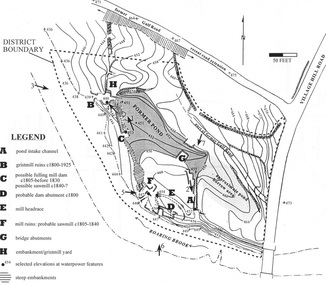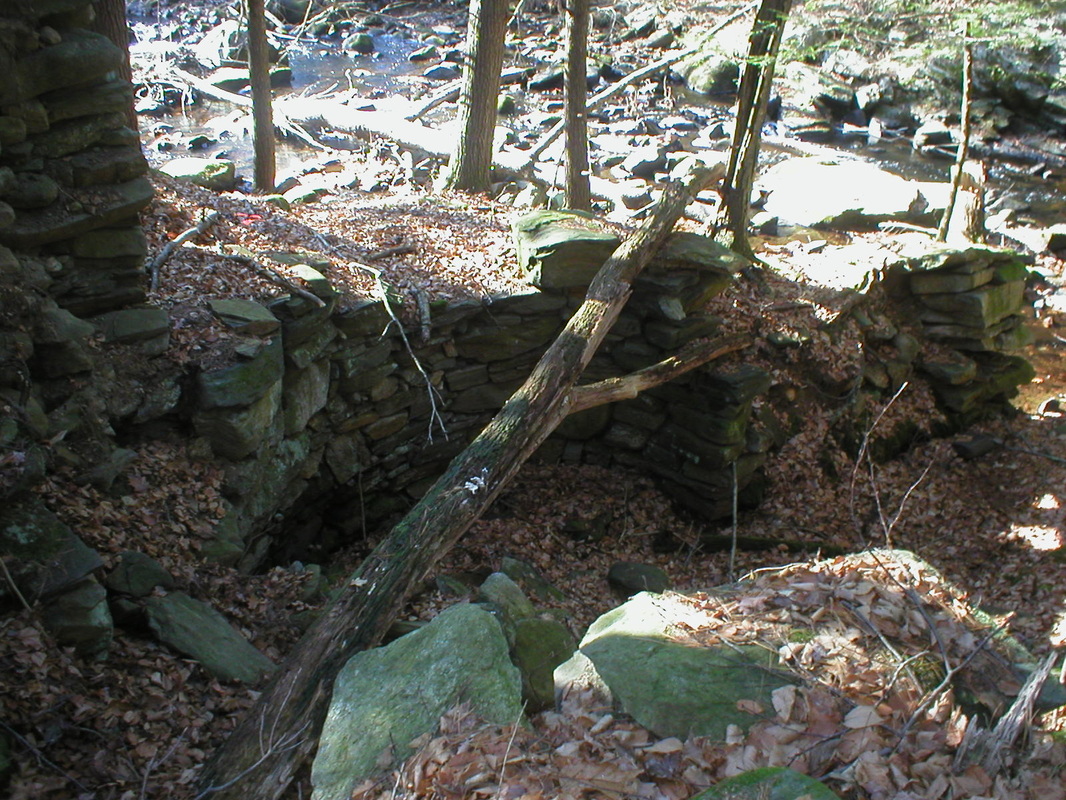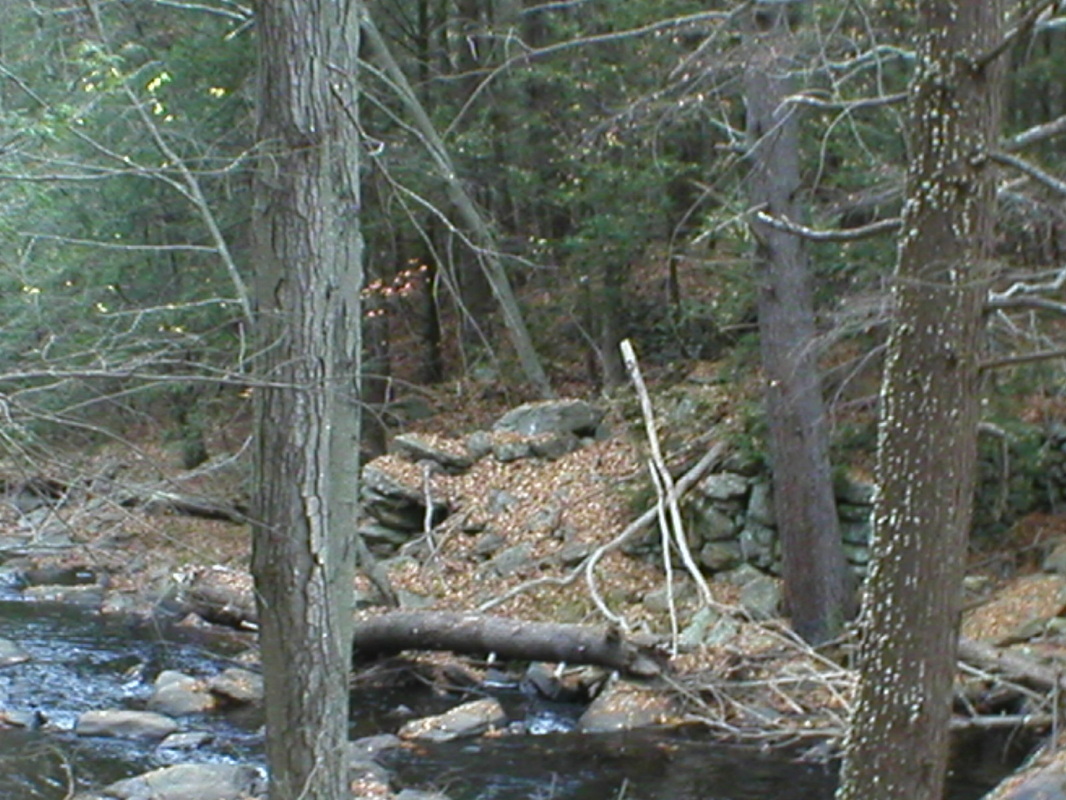Eldredge Mills (original) (raw)
eldredge mills, Village hill road

Waterway: Roaring Brook
Water power
: Turbines
Mill type: Saw mill, grist mill, shingle mill, fulling mill, wood-toothed hay rakes factory, clothier shop, turning shop, bobbin shop, blacksmith shop; a wooden rake factory; and a thread mill.
History – Eldredge Mills was one more active mill sites in Willington earning a position on the National Historical Register and designated as the Eldredge Mills Archaeological District, 00000938, site 160-15. Receiving its listing on October 20, 2000, the site designation was received on the basis of its agricultural processing and industrial manufacturing history. Although there were a number of early millers and owners of the site, it is commonly known as Eldredge Mills for owner Elijah Eldredge who purchased three existing mills there, circa 1812 to 1813. Much of the site was constructed between 1800 1807. Eldredge’s purchase was describe as a “dam associated with a saw mill, an undisclosed flume or head race structure, the house east of Village Hill Road, and a small clothier factory near the mill probably involved in non-water powered wool carding operations.”
After Elijah Eldredge purchased the site, he made a number of modifications including construction of a small off-stream pond, circa 1830, to increase the water in storage for power. Elijah Eldredge had sufficient supplies of water to power his mills so he had an agreement with Aron Chapman to erect a cotton mill, and leases were negotiated for a cotton mill, a clothier shop and a turning shop. The sites may have been on the south side of the brook, but question remains as to whether construction was ever completed.
The Eldredge family was the principal owners and operators between 1813 and 1845. Upon Elijah’s death in 1843, Eri, one of Elijah’s two sons, received 40 acres of his father’s property on the north side of the river containing a grist mill, saw mill, two shops, a shingle mill, as well as a house and a barn. In addition to the main mill site, the Eldredges operated a non-water powered wood-toothed rake shop and blacksmith shop on the south side of Roaring Brook, upstream of Village Hill Road bridge, circa I840-1885.
In 1845, Eri, Elijah’s son, sold his 40 acre parcel to Henry Clark who sold to Nathan Mathews in 1849. In 1866 Mathews sold to three Parker Brothers, Jonas, Augustin, and Walter, who operated a spool shop. The Parkers closed their spool shop in 1870 and sold to George Aldrich who owned the property for about 20 years. He may have been one of the last of the millers as he was running a grist mill six months of the year in 1870 and in 1880 he was running a saw mill three months of the year. By the end of the 1800s, most of the water powered mill operations had ceased with the grist mill being the last of the mills to operate. The mill finally ceased operations circa 1925.
Industrial operations along the brook, while the mills were in operations, included: grist, saw, fulling, and shingle mills; a clothier shop; a turning shop; a bobbin shop; a blacksmith shop; a wooden rake factory; and a thread mill. Some of the shops were not water powered, and some of the operations involved re-use of earlier structures_._
Initially Nehemiah Parker obtained the site, part of the Roger Wolcott land grant, in 1750. He operated a grist mill at the site. Later Jonathan Parker and his son Daniel operated the grist mill, perhaps one of the earlier mills activities on the site. Willard Low built a saw mill and a fulling mill between the bridge and the gristmill circa 1803 – 1807. Low sold his property to the Jonathan Parker in 1807 and the site being sold to Eldredge about five years later by the Parker family. The mill site was an active mill site from 1800 to 1925.
Site Characteristics: Eldredge Mills was located on a 2.25 acre site along a 550 foot section of Roaring Brook at the lower end of Village Hill Road where a 2,500 foot section of Roaring Brook drops 70 feet in elevation. It is between the junction of Keene Brook to the east and Route 32 to the west and just downstream from the current Village Hill Road bridge crossing Roaring Brook. It may have included as many as eight structures, but there are seven that have been positively identified as to location and purpose. In addition to the seven mill buildings, the complex included a pond, stone- faced sluiceway, off-stream saw mill dam, a flume and head race structure, and four wheel pits. Also included was a house and small clothier factory including a wool carding operation An abandoned road, Gulf Road, traversed the northern part of the site to serve the mills.
Many remnants remain in place - building foundations, wheel pits and sluiceways. In spite of the remnants remaining, it was still difficult to fully document the site. The loss of dam and sluiceway features due to periodic flooding, site changes due to bridge relocations, and site modifications, particularly by Eldredge, destroyed many of the early features. Wing dams, long sluiceways, and turbines were used for water power. There is some discrepancy as to whether turbine power was the only source of power at the site. There was one site between the saw mill and grist mill locations that possibly could have supported a standard water wheel and may have been used for one of the earlier mills. The type of wheel could not be determined because of the many additions and modifications to the site. The turbine pits are clearly visible today.
An on-site pond was constructed by Eldredge sometime between 1813 and 1830. Water supplied the pond via a long 550 to 600 ft. sluiceway originating near the junction of Keene and Roaring Brooks some distance above the former Village Hill road bridges. The detailed evidence of this water source has been obscured due to the construction and relocation of Route 15, I-84, and the Village Hill Road bridge over Roaring Brook. Along with continuing destruction due to periodic floods, most evidence has disappeared with some scattered evidence still remaining.
Additional Sources of Information: Upcoming book on Willington’s Lost Mill Sites
Turbine Pit  It is the lower of two adjoining turbine pits at the grist mill site shown in the sketch on page 45. Photo by the author It is the lower of two adjoining turbine pits at the grist mill site shown in the sketch on page 45. Photo by the author |
Mill Remnants  Mill remnants looking northerly across Roaring Brook. Photo by the author Mill remnants looking northerly across Roaring Brook. Photo by the author |
|---|